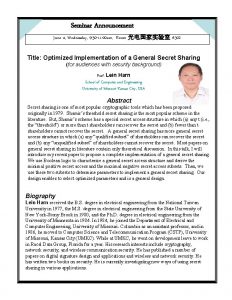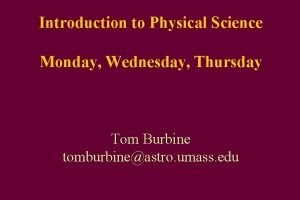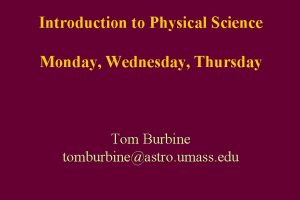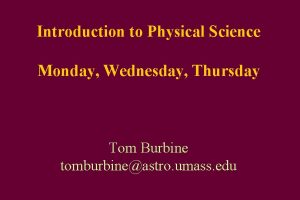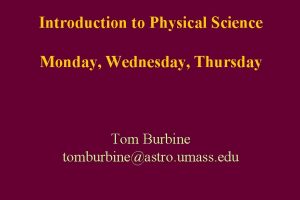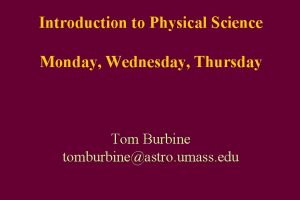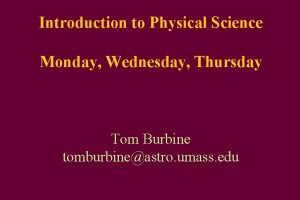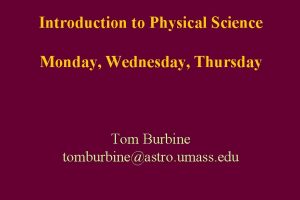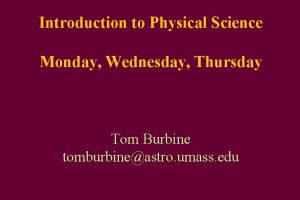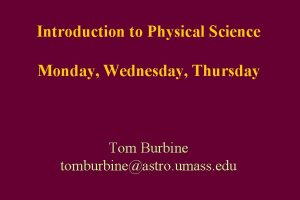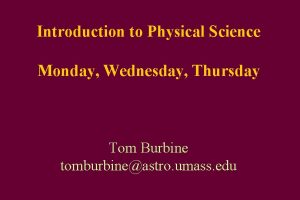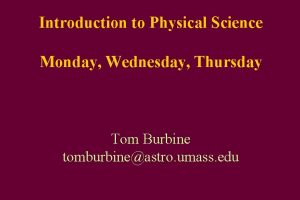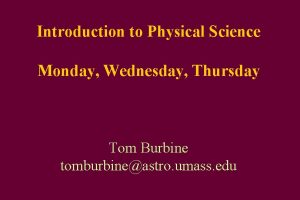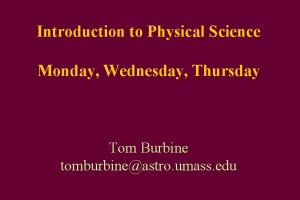Introduction to Physical Science Monday Wednesday Thursday Tom



















- Slides: 19

Introduction to Physical Science Monday, Wednesday, Thursday Tom Burbine tomburbine@astro. umass. edu

Density • Density = Mass/Volume • Mass is usually in grams or kilograms • Volume is usually in cm³ or m³

Densities • Density of water = 1 g/cm³ = 1, 000 kg/m³ • Density of iron = ~8 g/cm³ = ~8, 000 kg/m³

Weight density • Weight density = weight/volume

Pressure • Pressure = Force/Area • Unit of pressure is a Pascal, – which is a newton per square meter

Pressure in a liquid • When you swim, you feel the pressure of the water plus air above you • It is the weight of the fluids (water and air) above you • Swim deeper, more pressure

Pressure in a Liquid • Liquid pressure = weight density x depth

Pressure in a liquid • Liquid pressure is exerted equally in all directions

Buoyant Force • Upward acting force, caused by fluid pressure, that opposes an object's weight


Equal Volumes • Equal volumes feel equal buoyant forces • Cork would float, aluminum would sink, and lead would sink faster • Difference in their behavior is due to their weight

Archimedes (287 BC-212 BC) • Greatest scientist of antiquity • Needed to determine if silver had been substituted for gold in a crown for a king • Mass could easily be determined but not mass • Discovered that you could determine the volume of the crown by submerging it in water • Density (mass/volume) could be determined and compared to pure gold • This story may not be true

Archimedes Principle • An immersed body is buoyed up by a force equal to the weight of the fluid it displaces

Meaning • When an object is immersed in water, it feels lighter • Apparent weight of object is the weight of object minus the buoyant force N N 3 N of

Principle of Flotation • A floating object displaces a weight of fluid equal to its own weight

Why does an iron ship float? • Iron is about eight times as dense as water • When submerged, displaces 1/8 of a ton of water • If the iron is in a bowl and displaces 1 ton of water, it floats

• Buoyant force equals the weight of the fluid it displaces • Denser fluids exert more buoyant force upon a body than less-dense fluids of the same volume • A ship floats higher in salt water than in fresh water because salt water is slightly denser than fresh water so it has higher mass and exerts a higher buoyant force

• http: //www. youtube. com/watch? v=e. Qsmq 3 Hu 9 HA

Any Questions?
 Monday tuesday wednesday thursday friday calendar
Monday tuesday wednesday thursday friday calendar Monday tuesday wednesday thursday friday saturday sunday
Monday tuesday wednesday thursday friday saturday sunday Monday wednesday tuesday thursday
Monday wednesday tuesday thursday Tuesday-sunday
Tuesday-sunday Marvelous monday terrific tuesday wonderful wednesday
Marvelous monday terrific tuesday wonderful wednesday Enum week sunday monday
Enum week sunday monday Monday=621 tuesday=732 wednesday=933
Monday=621 tuesday=732 wednesday=933 Monday=621 tuesday=732 wednesday=933
Monday=621 tuesday=732 wednesday=933 Monday through thursday
Monday through thursday Go 910
Go 910 Symbols in the devil and tom walker
Symbols in the devil and tom walker Mind map branches of science
Mind map branches of science Natural and physical science
Natural and physical science My favourite subject
My favourite subject Extra credit
Extra credit Wednesday evening prayer
Wednesday evening prayer Wednesday seminar
Wednesday seminar Ib grades to percentage
Ib grades to percentage Web analytics wednesday
Web analytics wednesday Again
Again
















